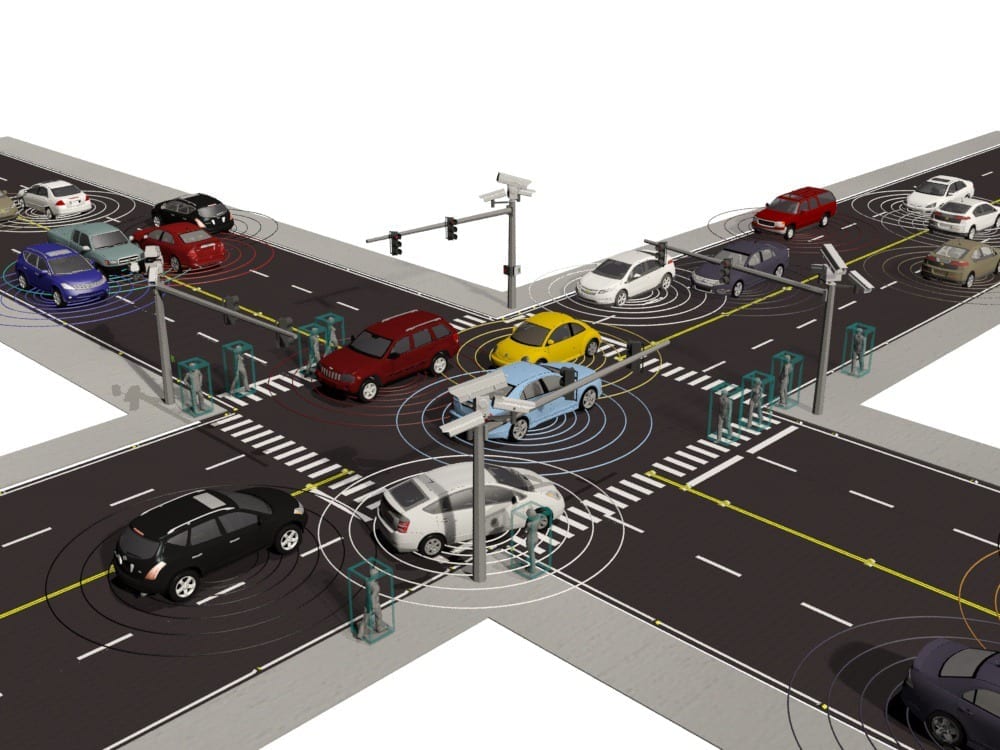
Computational framework for optimizing traffic flow could be the beginning of a road revolution
Drivers trying to get to work or home in a hurry know traffic congestion wastes a lot of time, but it also wastes a lot of fuel. In 2011, congestion caused people in US urban areas to travel an extra 5.5 billion hours and purchase an extra 2.9 billion gallons of fuel costing $121 billion. But despite the tangle of vehicles at busy intersections and interstate ramps, most of the country’s highways are open road with vehicles occupying only about 5 percent of road surface.
Scientists with the Urban Dynamics Institute (UDI) at the Department of Energy’s Oak Ridge National Laboratory are working to reduce travel time and fuel consumption by developing a computational framework for connected vehicle technologies that facilitate vehicle-to-vehicle communication, as well as communication between vehicles and traffic controls like traffic lights. Researchers envision vehicles exchanging information—such as location, speed, and destination—to generate individualized instructions for drivers. Watch a visualization of the process:
“By telling drivers the optimal speed, the best lane to drive in, or the best route to take, we can eliminate stop-and-go driving and improve safety,” said Andreas Malikopoulos, UDI deputy director and principal investigator of the project. “As a driver, you may get additional instructions suggesting you change lanes or follow a different path that may not be the route your GPS would give you to avoid congestion.”
The first step for the project team is developing decentralized control algorithms that govern how vehicles will communicate locally among vehicles interacting directly on the road but also act globally to optimize traffic flow across a city. The computational framework uses “decentralized control” algorithms because, realistically, all the vehicles in a city cannot communicate information to a central control center due to the staggering amount of data that would be involved.
Read more: Connecting Vehicles
The Latest on: Connecting Vehicles
[google_news title=”” keyword=”Connecting Vehicles” num_posts=”10″ blurb_length=”0″ show_thumb=”left”]
via Google News
The Latest on: Connecting Vehicles
- Laredo Police arrest man in connection to multiple Casa Verde Apartments vehicle break-inson May 8, 2024 at 8:14 pm
Laredo Police speak on the ongoing investigation of the individual being arrested for breaking into 7 cars and share how you can protect yourself from would-be criminals.
- Boy, 16, arrested for car-to-car shooting on Southern California freewayon May 8, 2024 at 6:17 pm
A 16-year-old boy and a 21-year-old man have been arrested in connection with a car-to-car shooting on a Southern California freeway that left a woman hospitalized last month, authorities ...
- US could ban Chinese connected vehicles or impose restrictionson May 8, 2024 at 3:26 pm
The U.S. could take "extreme action" and ban Chinese connected vehicles or impose restrictions on them, Commerce Secretary Gina Raimondo said on Wednesday, in the first indication a ban could be on ...
- US could ban Chinese connected vehicles or impose restrictions, US commerce secretary sayson May 8, 2024 at 1:59 pm
U.S. Commerce Secretary Gina Raimondo said on Wednesday the Biden administration could take an "extreme action" and ban Chinese connected vehicles or opt to impose restrictions but must first review ...
- Topeka man arrested in connection to crashing into multiple detached garages with stolen vehicleon May 8, 2024 at 1:00 pm
TOPEKA, Kan. (WIBW) - A Topeka man is behind bars in connection to crashing into multiple detached garages with a stolen vehicle.
- Could China spy on you through your car? Sen. Sherrod Brown backs ban of Chinese connected vehicles, componentson May 8, 2024 at 6:05 am
The U.S. Commerce Department is examining whether to regulate the connected vehicles supply chain to keep China out, arguing that foreign governments with access to connected vehicles could pose a ...
- Baltimore man arrested for murder in connection to man found dead in abandoned caron May 8, 2024 at 3:16 am
A second man has been arrested in connection to a murder back in January of a Maryland man found dead in a car in Frederick County. On Tuesday, deputies located and arrested 23-year-old Alonzo Michael ...
- ‘A horrible feeling:’ Domestic violence survivor says connected car was used to track heron May 5, 2024 at 7:46 pm
Christine Dowdall said she soon noticed a strange message pop up in her car. It turned out to be a location tracker through her car. She then realized her estranged husband was using her Mercedes Benz ...
- Person arrested in connection to car with North Carolina plates stolen with the owner still insideon May 4, 2024 at 8:35 pm
Police arrested a person in connection to a car with North Carolina plates that was carjacked with a victim still inside, officials said.
- How connected vehicle technology is changing Metro Detroit's roadson May 2, 2024 at 7:53 pm
An express lane on I-94 is being used to test connected and automated vehicle technology. MDOT hopes this kind of technology can improve safety.
via Bing News










